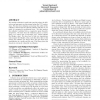Free Online Productivity Tools
i2Speak
i2Symbol
i2OCR
iTex2Img
iWeb2Print
iWeb2Shot
i2Type
iPdf2Split
iPdf2Merge
i2Bopomofo
i2Arabic
i2Style
i2Image
i2PDF
iLatex2Rtf
Sci2ools
ATAL
2010
Springer
2010
Springer
Honor among thieves: collusion in multi-unit auctions
We consider collusion in multi-unit auctions where the allocation and payments are determined using the VCG mechanism. We show how collusion can increase the utility of the colluders, characterize the optimal collusion and show it can easily be computed in polynomial time. We then analyze the colluders' coalition from a cooperative game theoretic perspective. We show that the collusion game is a convex game, so it always has a non-empty core, which contains the Shapley value. We show how to find core imputations and compute the Shapley value, and thus show that in this setting the colluders can always share the gain from their manipulation in a stable and fair way. This shows that this domain is extremely vulnerable to collusion. Categories and Subject Descriptors F.2 [Theory of Computation]: Analysis of Algorithms and Problem Complexity; I.2.11 [Artificial Intelligence]: Distributed Artificial Intelligence--Multiagent Systems; J.4 [Computer Applications]: Social and Behavioral S...
| Added | 08 Nov 2010 |
| Updated | 08 Nov 2010 |
| Type | Conference |
| Year | 2010 |
| Where | ATAL |
| Authors | Yoram Bachrach |
Comments (0)

